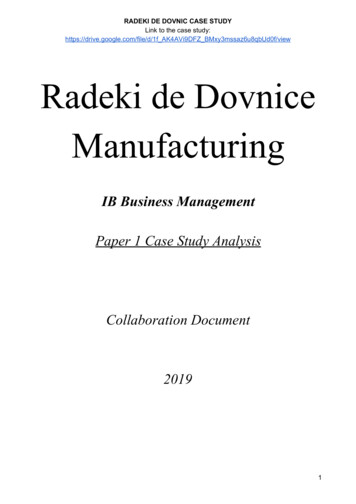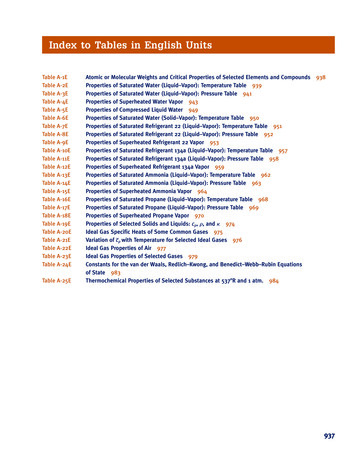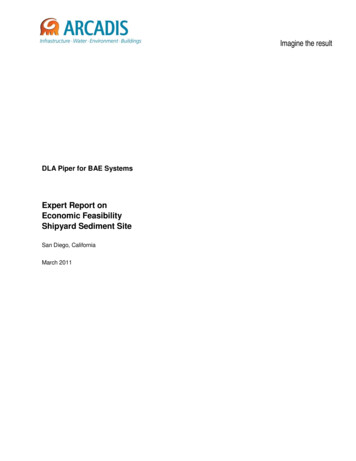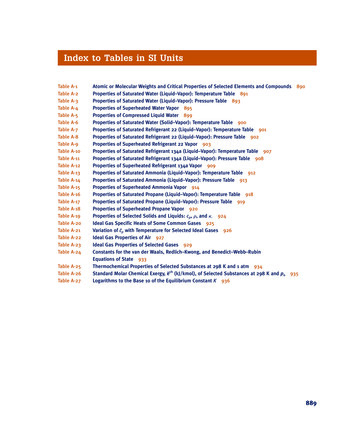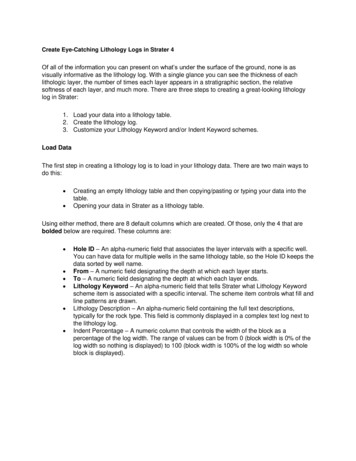
Transcription
1Table of ContentsMessage from the ACM Mid-Southeast Chapter Chair. 3ACM Mid-Southeast Chapter Officers. 4ACM Mid-Southeast Fall 2008 Conference Committee. 4Roster of Judges. 5Roster of Session Chairs . 6Conference Program . 7Keynote Address. 19AbstractsUndergraduate Students . 21Master’s Degree Students. 39Ph.D. Students . 49Professional . 61Conference at a Glance. 95
2
3Message from the Chapter ChairOn behalf of the Association for Computing Machinery (ACM) Mid-SoutheastChapter executives, I welcome you to this year’s Fall Conference in scenicGatlinburg, Tennessee. ACM is one of the oldest, largest and most renownededucational and scientific computing society and our chapter is one of theoldest.The chapter is proud of its rich traditions. The membership is small enoughfor everyone to know and be known by everyone else (about 100), but diverseenough to accommodate nearly all areas of computing. In keeping with thetraditions that make the membership return year after year, the conferenceoffers an opportunity for collegiality, renewal of friendships, and the makingnew friendships that are likely to last for years. The diversity represented bythe chapter’s membership will be evidenced by the cross section ofpresentations in scholarship, pedagogy, roundtable and poolside discussions.There should be something for everyone. Perhaps one of the best parts of theconference is the presentations by our students. We are excited to have thesebright young minds join us and to challenge us. Take a minute during theconference to stop and say hello and thank them for their contribution to thisconference.If you have not yet taken the time to join the chapter, please do so. Our duesare very reasonable and help make this wonderful conference possible.Everyone is welcome. There are two membership categories, the professionalcategory at 10.00 per a year, and student membership at 5.00 per year; pleasedo join us as we continuously explore and share the joy of learning andteaching Computer Science and Information Technology.If I have not found you to say hello join me and your colleagues in thehospitality suite. It is a great place to renew the old and make new friendships.Once again, welcome and enjoy the conference and beautiful Gatlinburg.Kathy Winters, ChairUniversity of Tennessee–Chattanooga.
4Chapter OfficersChairVice ChairKathy WintersUniversity of Tennessee–ChattanoogaKathy-Winters@utc.eduJim ClarkUniversity of Brenda ParkerMiddle Tennessee State Universitycsbrenda@mtsu.eduBob BradleyUniversity of Tennessee–Martinbbradley@utm.eduWebmasterJudy HankinsMiddle Tennessee State Universitycsjudy@mtsu.eduConference CommitteeConference ChairProgram ChairJim ClarkUniversity of Tennessee–Martinjclark@utm.eduDenise WilliamsUniversity of Tennessee–Martindenisew@utm.eduStudent Paper CompetitionHospitality SuiteRandy SmithUniversity of Alabamarsmith@cs.ua.eduJune WestSpartanburg Community Collegewestj@sccsc.edu
5Student Paper Competition JudgesChairRandy Smith, University of AlabamaUndergraduateDavid Frazier, East Tennessee State UniversityNancy Smithfield, Austin Peay State UniversityGlenn Wiggins, Mississippi CollegeMaster’sGreg Kawell, Samford UniversityMedha Sarkar, Middle Tennessee State UniversityMelissa Wiggins, Mississippi CollegePh.D.Srinivasarao Krishnaprasad, Jacksonville State UniversityTony Pittarese, East Tennessee State UniversityWayne Summers, Columbus State UniversityAlternatesDonald Sanderson, East Tennessee State University
6Session ChairsAzalea RoomSession I:Session II:Session III:Session IV:Wayne Summers, Columbus State UniversityJoyce Crowell, Belmont UniversityMedha Sarkar, Middle Tennessee State UniversityGreg Kawell, Samford UniversityDogwood ISession I:Session II:Session III:Session IV:Session V:David Frazier, East Tennessee State UniversityNancy Smithfield, Austin Peay State UniversityGlenn Wiggins, Mississippi CollegeOtha Britton, University of Tennessee–MartinPostersDogwood IISession I:Session II:Session III:Session IV:Session V:Ashraful Chowdhury, Georgia Perimeter CollegeRichard Detmer, Middle Tennessee State UniversityJim Vandergriff, Austin Peay State UniversityTony Pittarese, East Tennessee State UniversityKen Adcock, Cleveland State Community CollegeHighlander RoomSession I:Session II:Session III:Session IV:Julian Boggess Mississippi State UniversityJim Johnson, Bethel CollegeBrenda Parker, Middle Tennessee State UniversityBrian Toone, Samford UniversityAlternatesAllan Anderson, Northeast State Technical CommunityCollegeDenise Williams, University of Tennessee–MartinKathy Winters, University of Tennessee–Chattanooga
7ACM Mid-Southeast Chapter2008 Fall ConferenceGatlinburg, TennesseeGlenstone LodgeThursday, November 20, 20084:00 – 6:00 p.m.6:00 – 7:30 p.m.7:30 – 9:00 p.m.9:00 – 12:00 a.m.RegistrationSocial Meeting, Hospitality SuiteDinner — Individual ArrangementsSocial Gathering, Hospitality SuiteFriday, November 21, 20087:30 – 9:00 a.m.Registration7:30 – 8:00 a.m.Morning Coffee Sponsored byCourse Technology8:00 – 8:10 a.m.Welcome/Announcements — Azalea RoomWelcomeChapter ChairConference AnnouncementsConference ChairProgram AnnouncementsProgram Chair8:10 – 9:00 a.m.Keynote Address9:00 – 9:15 a.m.Coffee Break Sponsored by Course Technology
8Session I:9:15 – 10:35 a.m.Azalea Room:Doctoral Degree PresentationsSession Chair: Wayne Summers, Columbus StateUniversity9:15 – 9:35The Performance of Ontology Creation Tools, LaurenBiggers, University of Alabama9:35 – 9:55Ontology Conceptual Expansion, Liping Zhou, Universityof Alabama–Birmingham9:55 – 10:15Performance Study of Channel Allocation Algorithm with Tricommmunication Model, Sungbum Hong, Jackson StateUniversity10:15 –10:45CancelledDogwood I:Undergraduate PresentationsSession Chair: David Frazier, East Tennessee StateUniversity9:15 – 9:35A Comparison of Metaprogramming Techniques to SupportCode Coverage Analysis of Test Cases, Timothy F Uptain,University of Alabama–Birmingham9:35 – 9:55Cancelled9:55 – 10:15Cancelled10:15 –10:35Increasing Retention in Computer Science by Using AliceTechniques, Tavaris Payton, Talladega CollegeDogwood II: Professional PresentationsSession Chair: Ashraful Chowdhury, GeorgiaPerimeter College
99:15 – 9:35Building Mobile Rings: Synergy of Ring-based Peer-to-PeerSystems and Mobile Ad-Hoc Networks, Wei Ding, AustinPeay State University9:35 – 9:55Assembly Language with Visual Studio, Richard C.Detmer Middle Tennessee State University9:55 – 10:15A Survey of Security Issues and Enhancements of SCADANetworks, Yingbing Yu and Sandip Patel, Austin PeayState University and Morgan State University10:15 –10:35Thinking Outside the Text Box, Alternative Approaches toHuman Computer Interaction, Ron Zucker, EastTennessee State UniversityHighlander Room:Professional PresentationsSession Chair: Julian Mississippi State University9:15 – 9:35Minimum Distance Permutations, Edward L. Bosworth,Columbus State University9:35 – 9:55Grass Roots Knowledge Management: A Case Study of KMin a Highly Technical Organization, Randy K. Smith, TheUniversity of Alabama9:55 – 10:15Cancelled10:15 –10:35Data Analysis Methods Using SQL Databases, B. WayneWalters, University of Southern Mississippi
10Session II:10:40 – 12:00 p.m.Azalea Room:Doctoral Degree PresentationsSession Chair: Joyce Crowell, Belmont University10:40 – 11:00Feature Location by Information Retrieval and Call Graph,Peng Shao, University of Alabama11:00 – 11:20Evaluating Color Harmony’s Role in Map Labeling, SussanEinakian, University of Alabama–Huntsville11:20 – 11:40Visual Summary for Tourist Attractions, Lin Yang,University of Alabama–Birmingham11:40 – 12:00A Client-Server System for Simulating and Visualizing theRandom Packing of Polydisperse Spheres, Bruce Johnsonand Robert Lowe, University of Tennessee–KnoxvilleDogwood I:Undergraduate PresentationsSession Chair: Nancy Smithfield, Austin Peay StateUniversity10:40 – 11:00Robust Speech Synthesis and Understanding for a Robotic TourGuide, John Licato, University of South Alabama11:00 – 11:20The Virtual Collaborative Student Universe Project, DavidKolb, Columbus State University11:20 – 11:40Parallel Adventures With Conway’s Game of Life, AdamCorum, Brian Hawks, Ben Hollomon, and Ryan Hart,University of Tennessee–Martin11:40 – 12:00Cancelled
11Dogwood II:Professional PresentationsSession Chair: Richard Detmer, Middle TennesseeState University10:40 – 11:00Does Paired Programming Really Work?, Kathy Winters,University of Tennessee–Chattanooga11:00 – 11:20Dependency Injection, Aspect Oriented Programming, and theSpring Framework: The Impact of Ideas in Software, Ken R.Adcock, Jr., United Parcel Service Development11:20 – 11:40Combining XML and TXL for Software Visualization,Medha Shukla Sarkar, Middle Tennessee StateUniversity11:40 – 12:00Comparison of Ethical Theories Mentioned in ComputerEthics Textbooks, Julian Eugene Mississippi StateUniversityHighlander Room:Professional PresentationsSession Chair: Jim Johnson, Bethel University10:40 – 11:00Using Alice to Introduce the Computer Science Discipline,Brenda Parker, Middle Tennessee State University11:00 – 11:20From CS Concept to K12 IT Support, Greg Kawell,Samford University11:20 – 11:40Using JavaScript to Support On-Line Content for MultipleLearning Styles, David L. Tarnoff, East Tennessee StateUniversity11:40 – 12:00The Future of Education–A Case for Ubiquitous, On-demandeLearning, Christopher C. Whitehead, Columbus StateUniversityLunchPatio Restaurant 12:00 – 1:00 p.m.
12Session III1:00 – 2:20 p.m.Azalea Room:Master’s Degree PresentationsSession Chair: Medha Sarkar, Middle Tennessee StateUniversity1:00 – 1:20A Fast, Approximate Detector for the W32.Simile Malware,Edna Milgo and Yasmine Kandissounon, ColumbusState University1:20 – 1:40An Unsupervised Protein Sequences Clustering AlgorithmUsing Functional Domain Information, Hua Zhong,University of Alabama–Birmingham1:40 – 2:00Cross Training for a Safer Tomorrow, Jeff Phillips, EastTennessee State University2:00 – 2:20Evaluation of STL by McCabe’s Cyclomatic Complexity,Xiaoyun Jiang, University of AlabamaDogwood I:Undergraduate PresentationsSession Chair: Glenn Wiggins, Mississippi College1:00 – 1:20On the Implementation of a Novel Boundary Representation fora Triangle Mesh, Eric Frees, University of Alabama–Birmingham1:20 – 1:40Navigation Simulation, Robert M. Rudnick and Jenny L.Plott, University of South Alabama1:40 – 2:00Autonomous Navigation, Exploration, and Visualizationwith the Khepera Robots, Brian Bodkin and JamesLancaster, Middle Tennessee State University2:00 – 2:20LABVIEW System to Measure Acoustic Impedance,Gregory D. McGee, II, Mississippi Valley StateUniversity
13Dogwood II:Professional PresentationsSession Chair: Jim Vandergriff, Austin Peay StateUniversity1:00 – 1:20Multi-Core Programming: Challenges and Solutions,Srinivasarao Krishnaprasad, Jacksonville StateUniversity1:20 – 1:40Investigating the Impact of Ajax on Server Load in a Web 2.0Application, Brian Toone, Samford University1:40 – 2:00ETSU's SAP Initiative, Tony Pittarese, East TennesseeState University2:00 – 2:20The Semantic Web: The Next Evolution of the WWW,Christopher C. Whitehead, Columbus State UniversityHighlander Room:Professional PresentationsSession Chair: Brenda Parker, Middle Tennessee StateUniversity1:00 – 1:20Web-Based Application to Assist with Testing and GradingComputer Programs, Bob Bradley and Otha Britton,University of Tennessee–Martin1:20 – 1:40Using Comic Books to Teach Introductory Computer ScienceConcepts, David Brown, Pellissippi State TechnicalCommunity College1:40 – 2:003 Years of Allison Applesauce, Phillip S. Young, JeremyEy, and Eric L. Brown, Tennessee TechnologicalUniversity2:00 – 2:20You Wonder Why a Student Would Pay 100 for a Text andThen Not Read It. Getting Students to Read the Text, T. F.Higginbotham, Southeastern Louisiana University
14BreakPoolside 2:20 – 2:35 p.m.Sponsored by Course TechnologySession IV2:35 – 3:55 p.m.Azalea Room:Master’s Degree PresentationsSession Chair: Greg Kawell, Samford University2:35 – 2:55JagBot - A Fully Autonomous Tour Guide Robot, CharlesV. Smith III, Michael Skinner, and James Sakalaukus,University of South Alabama2:55 – 3:15Using Perl to Statically Analyze C Code, Paul Cleaveland,East Tennessee State University3:15 – 3:35The Future is Multi-Touch, Rathy Mohan, ColumbusState University3:35 – 3:55Extensible Software Requirements, Christopher Kilgore,East Tennessee State UniversityDogwood I:Undergraduate PresentationsSession Chair: Otha Britton, University of Tennessee–Martin2:35 – 2:55IDL-Wave: an Application for the NASA/TIMEDSatellite Team, Ameer Armaly and Sean Wilson,Furman University2:55 – 3:15Creating Application Shutdown Scripts for the Caterpillar Inc.Server Maintenance Process, DeMarcus Thomas,Mississippi Valley State University3:15 – 3:35Computational Solutions of Newton’s Laws of Motion,Shawn Bordeaux, Talladega College3:35 – 3:55Arithmetic Extension of an Expert System Shell, BrittanyStreeter, Talladega College
15Dogwood II:Doctoral Degree/Professional PresentationsSession Chair: Tony Pittarese, East Tennessee StateUniversity2:35 – 2:55Cycles in XML Schema and Data Integration, Lila Razaviand Susan V. Vrbsky, University of Alabama2:55 – 3:15A Transdisciplinary Approach Towards Clinical ResearchEvaluation, Varadraj Prabhu Gurupur, University ofAlabama–Birmingham3:15 – 3:35Matching UML Class Diagrams Across Reverse EngineeringTools, Yan Liang, University of Alabama3:35 – 3:55Godel and the Use of Automated Theorem Proving Software,David Frazier, East Tennessee State University(Professional Presentation)Highlander Room:Professional PresentationsSession Chair: Brian Toone, Samford University2:35 – 2:55A Curriculum for an Early Database Course to Support ITand CS Majors, Donald Sanderson, East TennesseeState University2:55 – 3:15IS Students, Ethics, and Social Responsibility, Vernon L.McGlone and Teresa A. McGlone, University of theCumberlands and Eastern Kentucky University3:15 – 3:35Server Side Programming and Php, Jim Vandergriff, AustinPeay State University3:35 – 3:55Behind the Scenes at the Annual Conference of the MidSoutheast Chapter of the ACM, Jim Clark, University ofTennessee–Martin
16Session V:4:00 – 5:00 p.m.Dogwood I:Undergraduate Posters/Presentations4:00 – 4:20Intra-Vehicle UWB Channel Measurements, Asia Walton,Talladega CollegeDogwood II:Professional PresentationsSession Chair: Ken Adcock, Cleveland StateCommunity College4:00 – 4:20Why Teach Assembly Language?, Edward L. Bosworth,Columbus State University4:20 – 4:40PedOGoGE: Pedagogical OpenGL Game Engine, JeffRoach, East Tennessee State University4:40 – 5:00Have Model Will Simulate!, Rodrigo Obando and WayneSummers, Columbus State University5:00 – 5:30 p.m.Business Meeting, Dogwood II5:30 – 7:00 p.m.Social Gathering, Hospitality Suite7:00 – 8:30 p.m.Awards Banquet, Azalea RoomEntertainment: Mike Edwards9:00 p.m.Social Gathering, Hospitality Suite
17Notes
18A special “thank you” goes to the The University ofAlabama at Birmingham, Edward Bosworth, and CourseTechnology for lending financial support to this year’sconference, and to students from the University ofTennessee–Martin Student Chapter of ACM for technicalsupport.
19Keynote AddressNetwork Performance for Clusters and GridsDr. Martin SwanyUniversity of DelawareHigh performance networks enable cluster and grid computing as viableparadigms. The achievable network performance is critical to the overallperformance of the system. Despite increases in the speed of both processorsand networks, there is a growing "network performance gap'' that limits theability to perform faster data movement. There are various bottlenecks toachievable network performance and consequently, many potential techniquesto improve performance. This talk explores techniques for improving networkperformance and explores potential evolution of network systems.
20About the SpeakerMartin Swany is an Assistant Professor in the Department of Computer andInformation Sciences at the University of Delaware. He received his B.A. andM.S. from the University of Tennessee in 1992 and 1998, respectively. Hecompleted his Ph.D. at the University of California, Santa Barbara in 2003 andjoined the faculty of the University of Delaware that year. He is a 2004recipient of the US Department of Energy Early Career Principal Investigatoraward. Since 2005, Swany has been the Internet2 Faculty Fellow involvingwork in network metrics and performance enhancing middleware. His researchinterests include high-performance parallel and distributed computing andnetworking.
21Student AbstractsUndergraduate Programs
22A Comparison of Metaprogramming Techniquesto Support Code Coverage Analysis of TestCasesTimothy F UptainFaculty Advisor: Dr. Jeff GrayUniversity of Alabama–BirminghamMetaprogramming uses reflection to adapt a program by allowing theinterpretation and meaning of a programming language to be altered atcompile-time or run-time. Javassist and OpenJava are two metaprogrammingenvironments that can be used to modify an existing Java application. Javassistworks directly with the bytecode of a compiled program and generates amodified representation that provides some new capability. OpenJava is asource-to-source translator that parses a program, applies metaobjects thatalter the parse tree, and outputs a modified version of the original source code.The methods used by both of these metaprogramming tools are similar, butdiffer based on their adaptation time (e.g., compile-time or load-time) and typeof artifact that is adapted (e.g., source code or byte code). Both of thesemetaprogramming environments allow the instrumentation of some newfeature or requirement into an existing application in an automated manner.This presentation describes an investigation that uses the metaprogrammingcapabilities of Javassist and OpenJava to instrument existing code to determinethe level of code coverage within a series of test cases. Code coverage analysisis a vital tool to assist in understanding the level of depth in software testing bydetermining how much of a program’s code is executed during a test case.Determining the depth of coverage of a program’s code during testing is avaluable asset because it can reveal any untested areas of a program, whichmight contain potential logic errors hidden in some obscure execution path.The presentation will offer an introduction to metaprogramming andreflection, describe the different techniques used in Javassist and OpenJava,and demonstrate how code coverage can be instrumented into existingapplications using both techniques.
23Younger Dryas Impact StudyCancelled
24Using the Intellibrain Robotics Platform forEducational and Research PurposesCancelled
25Increasing Retention in Computer Science byUsing Alice TechniquesTavaris PaytonFaculty Advisor: Syed RazaTalladega CollegeThe Higher Education Research Institute found that the number of collegefreshman interested in computer science as a major of study between 2000 and2005 dropped by 70% in the US, and the Taulbee Survey found that computerscience enrollment at research universities dropped by 50% (Kelleher, Pausch).Students are getting bored with the most popular tools and teachings that areused to acquaint them with programming. The stereotypical characteristics ofcomputer science play a very important role within these statistics. Thesecharacteristics include, but are not limited to computer science being boring,hard, geeky, and nerdy. This discourages students with exceptional andprominent math and computer skills. In order to overcome this problem,many different tools are being introduced to show students the brighter side ofcomputer science. One of those tools is Alice. Alice is a graphic program thatteaches students programming by using three-dimensional (3D) worlds andcharacters. Alice has been very successful because it motivates and excitesstudents of different ages. This research involves a 3D world using aninteractive environment that enhances the characters’ knowledge aboutcomputer science.
26Robust Speech Synthesis and Understanding fora Robotic Tour GuideJohn LicatoFaculty Advisors: Dr. Michael V. Doran and Dr. W. Eugene SimmonsUniversity of South AlabamaMicrosoft SAPI (Speech Application Programming Interface) allows for easyaccess to the speech synthesis and recognition features built into every versionof Microsoft’s Windows Vista. The library allows for individual words to berecognized, and for grammars to be programmed. These grammars allow for aprogrammable way to dynamically combine words and phrases and determineappropriate responses; a way to “understand” what was said. In the noisyenvironment of a college campus, a set of grammars were written with theintention of mounting a laptop and microphone atop a robot that would serveas a tour guide for students. The robot would use GPS and other tools todetermine its location, and the speech system would adjust its grammars andpreset responses depending on this information. The responses and grammarswere designed to allow for multiple variations of questions, taking into accountthe noisy environment and having the goal of a speech system that would notrequire user training – so that anyone could simply walk up and start talking toit.In an effort to create a more dynamic speech interface, we also modified thesystem so that it would have four grammars active at once: one for grammarsspecific to the current location, one for the general location, one that was notlocation-specific and an experimental fourth “dynamic” grammar which wouldbe used for future development. Using this system we were able to create aspeech interface with a high rate of recognition, even in a relatively noisyoutdoor environment.
27The Virtual Collaborative Student UniverseProjectDavid KolbColumbus State UniversityThe Virtual Collaborative Student Universe (VCSU) Project is an undertakingto create a 3d virtual world that students can produce content for andinstructors can use for class specific content. This paper will cover several ofthe conceptual ideas the project is seeking to implement in VCSU. These willinclude audio/visual art galleries for students, custom areas for gameprogramming students, classrooms for instructors and student dorm rooms.Also, it will survey previous uses of virtual worlds for education and thelessons we can draw from them going forward. Finally, these lessons will beapplied towards creating a 3d virtual environment fulfilling the project’s goals.
28Parallel Adventures With Conway’sGame of LifeAdam Corum, Brian Hawks, Ben Hollomon,and Ryan HartFaculty Advisor: Bob BradleyUniversity of Tennessee–MartinThis presentation will focus on our parallel implementations of Conway'sGame of Life. We will demonstrate both our GPU and CPU versions. OurGPU version was written using Microsoft's XNA programming library. It iswritten as a shader and does nearly all of its calculations entirely on the graphiccard's GPU. Since even cheap graphics cards have large amounts of on-boardRAM and hundreds of parallel processing pipelines, this allows the program tobe extremely fast (running thousand's of generations per second) and yet usehardly any CPU resources. We will talk about the advantages of doingcalculations on the GPU and also mention the challenges that this methodfaces. We will also demonstrate our parallel CPU version written using C# 3.0.This version uses the new C# parallel for-loop to allow it to take advantage ofmultiple CPU cores. We will show how easy it is to use this method anddemonstrate what kind of speed up it can offer your programs. Lastly we willdemonstrate our standard C version that we use as a benchmark for theother programs. And if time allows, we will demonstrate our not parallel, butvery portable, iPhone version.
29An Interactive Approach to Inspire Females inComputer ScienceCancelled
30On the Implementation of a Novel BoundaryRepresentation for a Triangle MeshEric FreesFaculty Advisor: Dr. John K. JohnstoneUniversity of Alabama–BirminghamThe representation of shape is one of the fundamental issues of computergraphics, and a dominant choice for the computer representation of shape isthe polygon mesh. A boundary representation (b-rep) of the mesh is a datastructure for storing the vertices, edges, and faces of the mesh so that access totopological relationships, such as a vertex's neighboring edges or a face'sneighboring faces, is efficient. A b-rep is crucial to the efficiency of mostalgorithms that work with a mesh.We consider a novel boundary representation, called the corner boundaryrepresentation, introduced by Ken Joy in 2003. The central element of thecorner b-rep is a lath with three pointers: a pointer to a vertex, a pointer to theneighboring lath moving clockwise within the face, and a pointer to theneighboring lath moving clockwise about the vertex. We consider theadvantages of the corner b-rep over other b-reps, including the winged edge,half edge, split edge, and quad edge.This talk is focused on the issues that arise in implementing the corner b-rep.Although open source implementations of other better known b-reps arewidely available, we are not aware of any implementations of the corner b-rep.We develop a key algorithm missing from Joy's paper: how to build the cornerb-rep of a mesh from a list of its vertices and faces (as in a typical mesh fileformat).
31Navigation SimulationRobert M. Rudnick and Jenny L. PlottUniversity of South AlabamaThe goal of the overall project is to create a tour guide robot that can givetours of campus to new and incoming students and attract students. Thiscomplex task has been divided into smaller tasks. Engineering students arebuilding the physical robot and working on basic movement and thefunctionality that it will need. A Computer Science student is working closelywith the engineering department on the robot's ability to use GPS todetermine where it is located and where it will need to go. Two CS studentshave developed a program that allows the robot to have an interactive dialogwith users. The project presented here is a simulation of the robot’s ability tofollow a path for a tour.The simulated routes will be useful when the actual robot begins to move as a“you are here” visualization of the path. In the process of this work it wasdecided that the robot would need to visit the CIS compound, theAdministration building, the Mitchell Center, the Bookstore/Student Centerarea, and the Engineering compound. We plotted paths and important pointsfor the robot to move through or stop at on maps of the necessary parts ofcampus. Along each path a variety of points were defined: location points,waypoints, speaking points, and decision points. When the robot reaches oneof these points the appropriate actions would take place. A graphicalsimulation has been implemented in C#. The focus of the simulation was theunderlying data structure. We created a linked list of points that could betraversed in either direction, with each decision point having a list of points towhich it is directly connected. To handle the different types of points,inheritance from a basic point class was used to create classes for the necessarytypes.
32Autonomous Navigation, Exploration, andVisualization with the Khepera RobotsBrian Bodkin and James LancasterFaculty Advisor: Dr. Cen LiMiddle Tennessee State UniversityThe Khepera robot is a miniature robot equipped with infrared distance and lightsensors and encoders. Khepera robots have been used in various experimental settingsfor research. In particular, it has been an ideal test bed for evolutionary algorithms andalgorithms for collective robot behavior generation. Khepera has also been used fortesting AI navigation algorithms in educational settings. There, the focus has been onreactive navigation, and on semi-autonomous, serial controlled navigation.This research work explored the capabilities of Khepera as a fully autonomous robotfor navigation and exploration. The research team first investigated the sensingcapabilities of the robot for navigation purposes. Based on the experimental results, anappropriate model mimicking a typical office floor layout was constructed. A hybridarchitecture was adopted for programming the robot. The hybrid architecture consistsof a high level, deliberative planning layer that is separated from a lower level, reactivebehavior execution layer. In the planning layer, the D* Lite search algorithm wasadapted to find the shortest path between a starting and a destination location. Aninternal map corresponding the environment is constructed and used in the planningstage. In the behavior execution layer, separate routines were developed that carries outthe navigation defined for pre-specified behaviors. The shortest path computed fromthe planning layer are passed to the executed by one instr
1:40 - 2:00 ETSU's SAP Initiative, Tony Pittarese, East Tennessee State University 2:00 - 2:20 The Semantic Web: The Next Evolution of the WWW, Christopher C. Whitehead, Columbus State University Highlander Room: Professional Presentations Session Chair: Brenda Parker, Middle Tennessee State University

